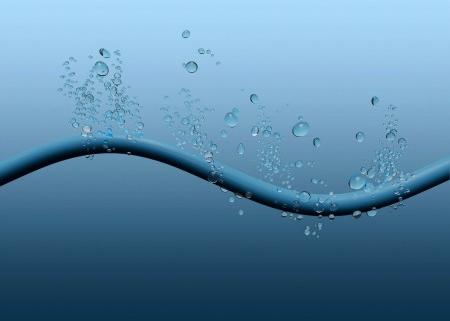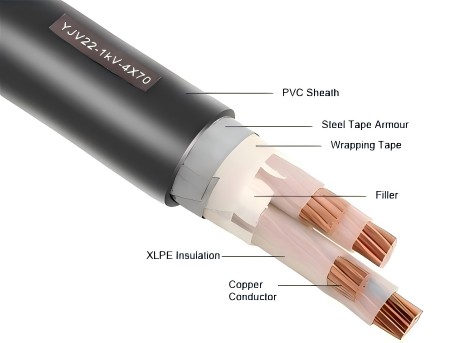1. What is waterproof cable?
Cables that can be used normally in water are collectively referred to as water-resistant (waterproof) power cables. When the cable is laid underwater, often immersed in water or wet places, the cable is required to have the function of water prevention (resistance), that is, it is required to have the function of full water resistance, in order to prevent water from immersing in the cable, causing damage to the cable, and ensuring the long-term stable operation of the cable under water. The commonly used waterproof cable model is JHS, which belongs to rubber sleeve waterproof cable, waterproof cable is also divided into waterproof power cable and waterproof computer cable, etc., and the model representatives are FS-YJY, FS-DJYP3VP3.
2. Type of waterproof cable structure
(1). For single-core cables, wrap the semi-conductive water blocking tape on the insulation shield, wrap the ordinary water blocking tape outside, and then squeeze the outer sheath, in order to ensure the full contact of the metal shield, only wrap the semi-conductive water blocking tape outside the insulation shield, the metal shield no longer wrap the water blocking tape, depending on the level of waterproof performance requirements, the filling can be filled with ordinary filler or water block filler. The inner lining and outer sheath materials are the same as those described in the single core cable.
(2). An plastic coated aluminum tape layer is longitudinally wrapped inside the outer sheath or inner lining layer as a waterproof layer.
(3). Extrude the HDPE outer sheath directly on the cable. The XLPE insulated cable above 110kV is equipped with a metal sheath to meet the waterproof requirements. The metal shield has complete impenetrability and good radial water resistance. The main types of metal sheath are: hot pressed aluminum sleeve, hot pressed lead sleeve, welded corrugated aluminum sleeve, welded corrugated steel sleeve, cold drawn metal sleeve and so on.
3. Waterproof form of waterproof cable
Generally divided into Vertical and radial water resistance two. Vertical water resistance is commonly used to water blocking yarn, water powder and water blocking tape, water resistance mechanism is in these materials contain a water can expand material, when the water from the cable end or from the sheath defect into, this material will rapidly expand water to prevent further diffusion along the cable longitudinal, to achieve the purpose of cable longitudinal waterproof. The radial water resistance is mainly achieved by extruding HDPE non-metallic sheath or hot pressing, welding and cold drawing metal sheath.
4. Classification of waterproof cables
There are mainly three types of waterproof cables used in China:
(1). Oil-paper insulated cable is the most typical water resistant cable. Its insulation and conductors are filled with cable oil, and there is a metal jacket (lead jacket or aluminum jacket) outside the insulation, which is the best water resistance cable. In the past, many submarine (or underwater) cables used oil-paper insulated cables, but oil-paper insulated cables are limited by the drop, there are trouble with oil leakage, and maintenance is inconvenient, and now they are used less and less.
(2). The ethylene propylene rubber insulated cable widely used in low and medium voltage underwater transmission lines is due to its superior insulation performance without the worry of “water tree”. Waterproof rubber sheathed cable (Type JHS) can operate safely in shallow water for a long time.
(3). Cross-linked polyethylene (XLPE) insulated power cable because of its excellent electrical, mechanical and physical properties, and the production process is simple, light structure, large transmission capacity, installation and maintenance is convenient, not limited by the drop and other advantages, become the most widely used insulation material, but it is particularly sensitive to moisture, in the manufacturing and operation process if the insulation has water impregnation, Prone to “water tree” breakdown, greatly shortening the service life of the cable. Therefore, the cross-linked polyethylene insulated cable, especially the medium and high voltage cable under the action of AC voltage, must have a “water blocking structure” when used in a water environment or wet environment.
5. The difference between waterproof cable and ordinary cable
The difference between waterproof cables and ordinary cables is that ordinary cables cannot be used in water. JHS waterproof cable is also a kind of rubber sheath flexible cable, the insulation is rubber insulation, and ordinary rubber sheath cable, JHS waterproof cable is often used, but it is in the water or some will pass through the water. Waterproof cables are generally 3 core, most of them are used when connecting the pump, the price of waterproof cables will be more expensive than ordinary rubber sheath cables, it is difficult to distinguish whether waterproof from the appearance, you need to consult the seller to know the waterproof layer.
6. The differences between waterproof cable and water resistant cable
Waterproof cable: prevent water from entering the interior of the cable structure, using a waterproof structure and materials.
Water blocking cable: The test allows water to enter the interior of the cable, and does not allow penetration to the specified length under specified conditions. Water blocking cable is divided into conductor water blocking and cable core water blocking.
Water-blocking structure of conductor: adding water-blocking powder and water blocking yarn in the process of single wire stranding, when the conductor enters water, the water blocking powder or water blocking yarn expands with water to prevent water penetration, of course, the solid conductor has better water-blocking performance.
Water blocking structure of cable core: when the outer sheath is damaged and the water enters, the water blocking tape expands. When the water blocking tape expands, it quickly forms a water blocking section to prevent further water penetration. For the three-core cable, it is very difficult to achieve the overall water resistance of the cable core, because the middle gap of the three-core cable core is large and irregular, even if the use of the water block is filled, the water resistance effect is not good, it is recommended that each core be produced according to the single-core water resistance structure, and then the cable is formed.
Post time: Oct-23-2024



